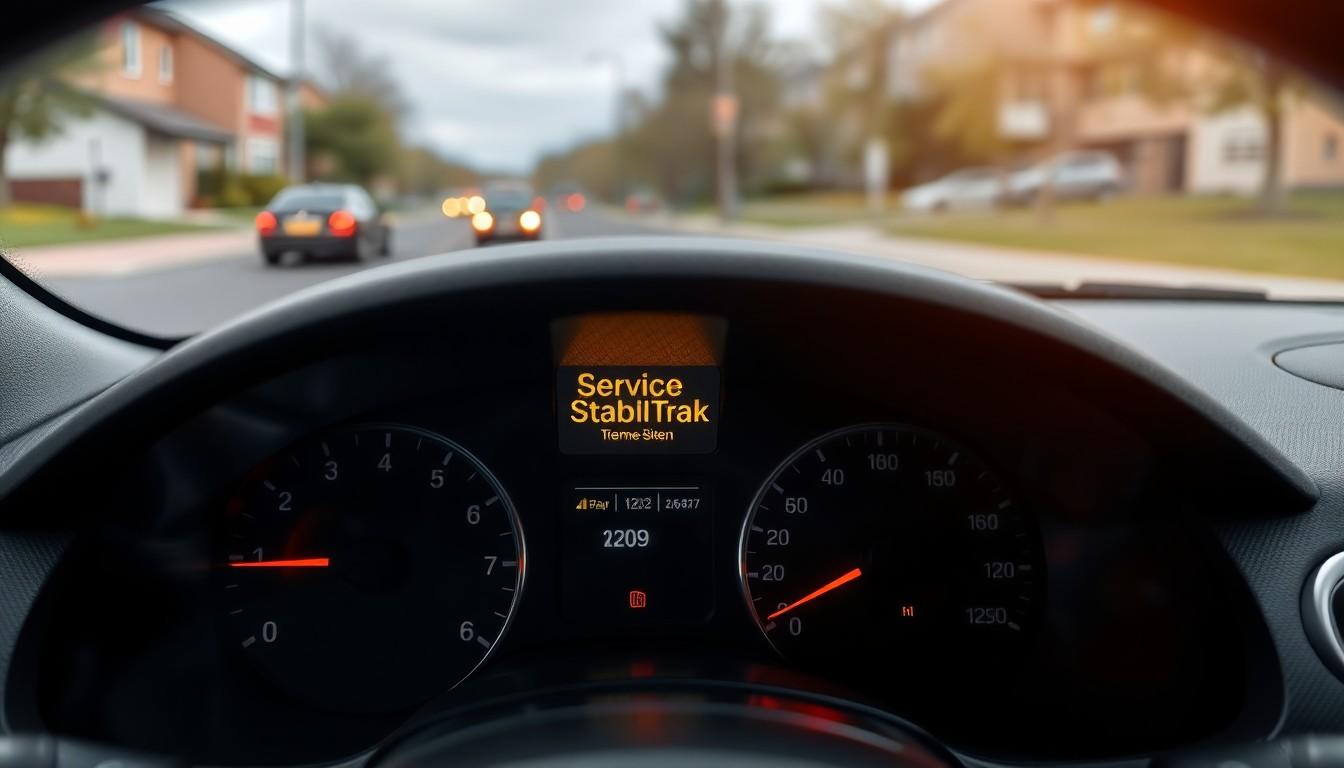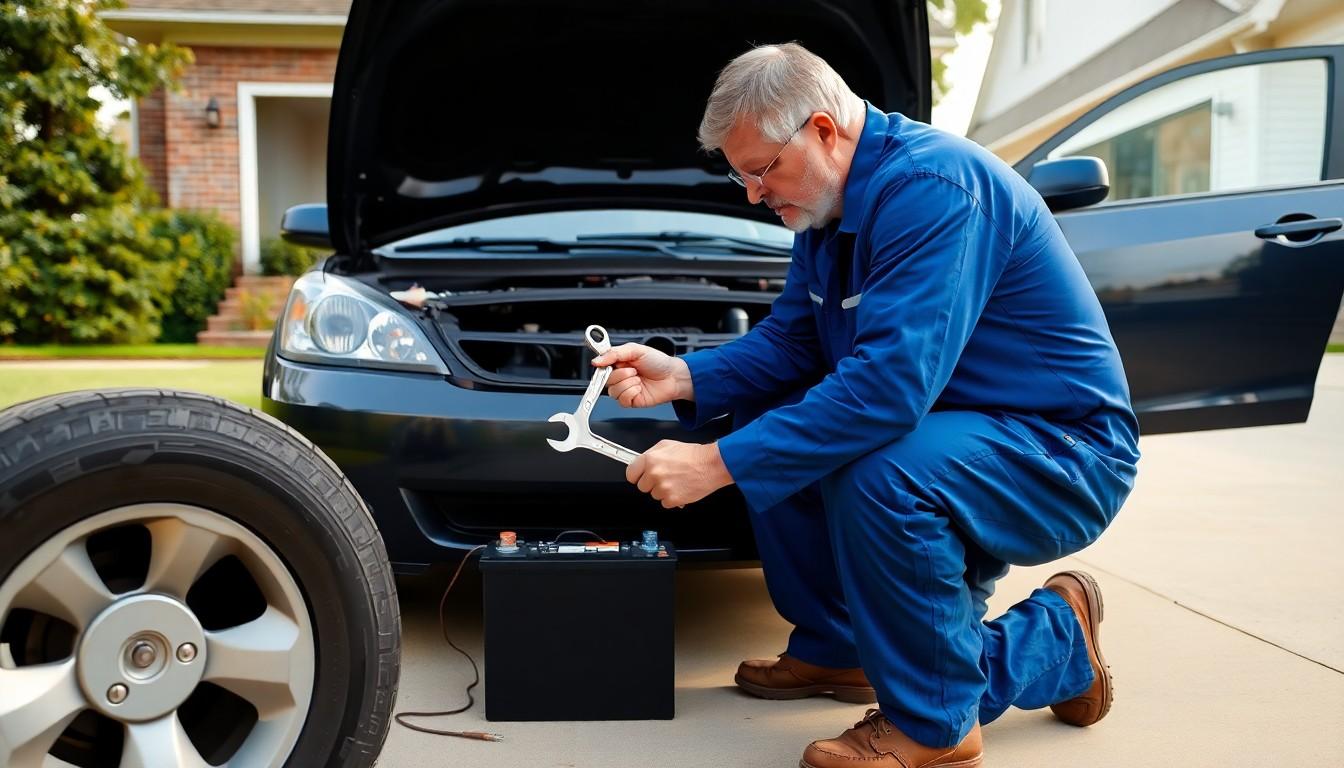Ever been driving along when that dreaded “Service StabiliTrak” warning pops up on your dashboard? This frustrating alert can leave you wondering if your vehicle is safe to operate and how quickly you need to address the issue.
We’ve guided countless drivers through StabiliTrak problems, and we’re here to help you too. This stability control system is crucial for maintaining control during challenging driving conditions, but when it fails, it doesn’t always mean an expensive trip to the dealership. Many StabiliTrak issues can be resolved with straightforward DIY approaches that we’ll walk you through step by step.
In this comprehensive guide, we’ll cover the most common causes of StabiliTrak failures and provide actionable answers that have worked for thousands of vehicle owners just like you.
What Is the StabiliTrak System and Why It Matters
StabiliTrak is General Motors’ electronic stability control system designed to help drivers maintain control of their vehicles during challenging driving conditions. This advanced safety feature continuously monitors steering input and vehicle motion, comparing the driver’s intended path with the vehicle’s actual direction. When it detects a potential loss of control, StabiliTrak automatically applies individual wheel brakes and adjusts engine power to help keep the vehicle on the intended course.
The system works by using multiple sensors throughout the vehicle to detect factors like:
- Steering wheel position
- Wheel speed
- Vehicle rotation
- Lateral acceleration
- Brake pressure
These sensors feed data to the vehicle’s computer, which determines if the car is about to skid or slide uncontrollably. Unlike traditional traction control systems that only manage wheel spin during acceleration, StabiliTrak provides comprehensive stability management in various driving scenarios.
StabiliTrak’s importance can’t be overstated for vehicle safety. According to the National Highway Traffic Safety Administration (NHTSA), electronic stability control systems like StabiliTrak reduce single-vehicle crashes by approximately 32% for passenger cars and 57% for SUVs. These systems have proven so effective that they’ve been mandatory equipment on all new passenger vehicles in the United States since 2012.
For everyday drivers, StabiliTrak offers critical assistance when encountering:
- Sudden emergency maneuvers
- Slippery road conditions from rain, snow, or ice
- Unexpected obstacles requiring quick steering adjustments
- Sharp turns or curves taken at excessive speeds
The system operates silently in the background during normal driving conditions, activating only when needed to help prevent accidents. Most drivers only notice StabiliTrak working when they see the dashboard indicator light flash momentarily during challenging driving situations.
Common Symptoms of StabiliTrak System Failure

Recognizing the warning signs of a failing StabiliTrak system helps you address problems before they worsen. These distinctive symptoms alert drivers to potential issues requiring attention for optimal vehicle performance and safety.
Warning Lights on Dashboard
The most obvious indicator of StabiliTrak failure is the illumination of the “Service StabiliTrak” warning light on your dashboard. This alert specifically targets issues with the stability control system and shouldn’t be ignored. The light typically appears as a yellow or amber icon, often accompanied by other warning indicators such as the traction control light or check engine light. Many drivers first notice this warning during startup or when driving in conditions that would normally activate the stability system.
Reduced Engine Power
StabiliTrak malfunctions frequently trigger the vehicle’s failsafe mode, resulting in noticeably reduced engine power. Your car might suddenly lose acceleration capability, struggling to exceed certain speeds even though pressing the gas pedal. This power limitation represents a protective measure designed to prevent potential damage to the vehicle’s components when the stability system isn’t functioning correctly. Drivers commonly report their vehicles becoming undrivable or operating in a severely limited capacity, making even routine trips challenging and potentially hazardous.
Unusual Vibrations or Handling Issues
A compromised StabiliTrak system often manifests through altered vehicle handling characteristics and unexpected vibrations. Your car may feel less responsive during turns or demonstrate unusual behavior when changing lanes. Steering might feel heavier or lighter than normal, and you could experience unexpected resistance when making maneuvers. Many drivers also report sensing vibrations through the steering wheel or sensing the vehicle shifting gears abnormally. These handling irregularities tend to become more pronounced during adverse road conditions like rain, snow, or uneven surfaces—precisely when the StabiliTrak system should be providing the most assistance.
Main Causes of Service StabiliTrak Problems

The “Service StabiliTrak” warning light typically illuminates when there’s a malfunction in your vehicle’s stability control system. Understanding these common causes helps pinpoint the exact issue affecting your GMC or Chevrolet vehicle.
Faulty Wheel Speed Sensors
Wheel speed sensors frequently trigger StabiliTrak warnings when they malfunction or become contaminated with road debris. These critical components provide essential data about individual wheel rotation speeds to the stability control system. Replacing a faulty wheel speed sensor resolves many StabiliTrak issues, though accessing the sensor can be challenging if it’s seized in the hub. Regular inspection of these sensors during routine maintenance helps prevent unexpected StabiliTrak failures.
Low Battery Voltage
Insufficient battery voltage often causes StabiliTrak system malfunctions because the electronic stability control requires consistent power to operate properly. Testing your battery’s charge level should be your first diagnostic step when experiencing StabiliTrak problems. Disconnecting the battery for approximately 10 minutes allows residual electrical charge to dissipate, effectively resetting the StabiliTrak system in many cases. Maintaining a properly charged battery not only prevents StabiliTrak issues but also extends the lifespan of other electronic components.
Defective Steering Angle Sensor
Steering angle sensors monitor the position and rate of steering wheel movement, providing crucial input to the StabiliTrak system. Malfunctions in this sensor directly impact the stability control system’s ability to determine driver intentions. Replacement of a defective steering angle sensor typically resolves associated StabiliTrak warnings. Professional diagnostic equipment can confirm whether this component requires attention before you invest in replacement parts.
Problematic Throttle Position Sensor
Throttle position sensors communicate accelerator pedal input to the engine control module, affecting how the StabiliTrak system manages power during stability interventions. Clogged or dirty throttle position sensors interfere with accurate readings, triggering StabiliTrak warnings and potentially reducing engine performance. Cleaning or replacing the throttle position sensor often resolves these issues. Also, the throttle body itself can accumulate carbon deposits that require cleaning to restore proper functionality and eliminate StabiliTrak warnings.
DIY Methods to Fix Service StabiliTrak

Several effective DIY approaches exist to address Service StabiliTrak issues without requiring a trip to the mechanic. These methods range from simple system resets to more involved sensor replacements, depending on the root cause of your problem.
Resetting the System
Resetting the StabiliTrak system often resolves temporary glitches that trigger warning lights. A manual reset starts with putting your vehicle in park and turning off the engine completely. Turn the steering wheel fully clockwise then counterclockwise, wait approximately 15 seconds, and restart your vehicle. The battery disconnect method offers another effective reset option – locate the battery under the hood, disconnect the negative terminal using a wrench, wait 10 minutes for electrical discharge, then reconnect securely. Using an OBD-II scanner provides a more technical approach by connecting it to the port under your dashboard and following the scanner’s prompts to reset the StabiliTrak system.
Cleaning Sensor Connections
Dirty sensor connections commonly trigger StabiliTrak warnings in GMC and Chevy vehicles. The throttle position sensor and throttle body require regular inspection and cleaning to remove debris that could interfere with proper functioning. Other sensors related to the StabiliTrak system, such as the power steering sensor, also benefit from careful cleaning when they accumulate dirt or contaminants. Regular maintenance of these connections helps prevent false warnings and ensures the stability control system operates correctly during critical driving situations.
Replacing Faulty Sensors
Identifying which component needs replacement starts with retrieving error codes through an OBD-II scanner. Common culprits include malfunctioning StabiliTrak sensors, power steering sensors, ABS pumps, brake light switches, and tire pressure sensors. Replacing worn spark plugs, clogged fuel injectors, bad fuel lines, or filters often resolves persistent StabiliTrak warnings. Additional system checks should include brake fluid levels, tire pressure verification, and fuel delivery components, as problems in these areas frequently trigger stability control warnings. Proper tire inflation particularly matters since uneven pressure across tires can cause the system to detect imbalanced traction conditions.
When to Seek Professional Help

Professional expertise becomes essential when DIY methods fail to resolve StabiliTrak issues. While many drivers successfully fix these problems with simple resets, some situations require specialized knowledge and equipment only available at service centers.
Diagnostic Testing Procedures
Professional technicians employ comprehensive diagnostic procedures to identify StabiliTrak issues precisely. They begin by connecting an OBD scanner to retrieve exact trouble codes that pinpoint the exact component causing the problem. Technicians then perform systematic inspections of brake fluid levels, checking for any leaks or contamination that might trigger warnings. Tire pressure tests follow, as improper inflation can interfere with wheel speed sensors and stability control functions. Experts also conduct thorough wiring inspections, looking for damaged connections, corrosion, or loose terminals throughout the system. Advanced diagnostic devices allow mechanics to recalibrate the StabiliTrak system when necessary, restoring proper functionality after repairs are completed.
Cost Expectations for Professional Repairs
StabiliTrak repair costs vary significantly depending on the underlying issue’s complexity. Simple diagnostics and minor repairs typically range between $100 and $300, including basic parts replacement and labor. Sensor replacements fall within this price range, with individual sensors costing $50-150 plus installation. More complex repairs involving multiple components or extensive troubleshooting can reach $500 or more, particularly when control modules need replacement. Labor charges account for a substantial portion of repair costs, with most service centers charging between $75-150 per hour for diagnostic time. Dealership services generally cost more than independent repair shops but may offer specialized expertise for complicated StabiliTrak issues. Some repairs might be covered under extended warranties or recall notices, making it worthwhile to check your vehicle’s coverage before proceeding with repairs.
Preventative Maintenance for StabiliTrak Systems

Regular maintenance prevents many common StabiliTrak issues before they develop into serious problems. Implementing these preventative measures helps maintain optimal system performance and extends the lifespan of your vehicle’s stability control components.
Regular Tire Maintenance
Tire pressure monitoring directly impacts StabiliTrak functionality. Checking tire pressure monthly ensures all tires maintain manufacturer-recommended PSI levels, preventing false StabiliTrak warnings. Uneven tire wear or important pressure differences between tires can trigger stability control system alerts, compromising vehicle handling during emergency maneuvers.
Fluid Level Monitoring
Brake fluid levels play a critical role in StabiliTrak operation. Inspecting brake fluid reservoirs during routine maintenance keeps the system functioning properly and prevents warning lights. Low brake fluid triggers StabiliTrak warnings as the stability control system relies on proper hydraulic pressure to apply individual wheel brakes during interventions.
Sensor Cleaning and Inspection
Throttle position sensors and throttle bodies require periodic cleaning to prevent buildup and malfunction. Dirt and debris accumulation on these components frequently causes StabiliTrak errors. Carefully inspecting wheel speed sensors for damage or contamination helps identify potential issues before they trigger system failures.
Electrical System Care
Battery health directly affects StabiliTrak performance. Testing battery voltage regularly prevents system malfunctions caused by insufficient power supply. Checking for loose or corroded electrical connections throughout the stability control system’s wiring harness eliminates intermittent issues that might otherwise be difficult to diagnose.
Professional System Scans
Scheduling periodic diagnostic scans detects potential StabiliTrak issues before warning lights appear. Professional technicians can identify developing problems with specialized equipment, allowing for early intervention. These preventative scans typically cost less than emergency repairs and help maintain consistent vehicle performance and safety.
Conclusion
Maintaining a properly functioning StabiliTrak system is crucial for your vehicle’s safety and performance. When that warning light appears don’t panic. With the troubleshooting steps we’ve outlined you can often resolve the issue yourself and save on costly repairs.
Remember that most StabiliTrak problems stem from sensor issues low battery voltage or electrical connections that can be addressed with regular maintenance. By staying proactive with tire pressure checks battery maintenance and routine inspections you’ll minimize the chances of stability system failures.
For issues beyond DIY answers professional diagnosis is always worth the investment. Your safety on the road especially in challenging driving conditions depends on these advanced stability systems working correctly.
Frequently Asked Questions
What is StabiliTrak?
StabiliTrak is General Motors’ electronic stability control system that helps maintain vehicle control in difficult driving conditions. It monitors steering input and vehicle motion, applying individual wheel brakes and adjusting engine power when it detects potential loss of control. This system significantly reduces the risk of single-vehicle crashes and provides assistance during sudden maneuvers, slippery conditions, and sharp turns.
What does the “Service StabiliTrak” warning mean?
The “Service StabiliTrak” warning indicates an issue with your vehicle’s stability control system. This warning light means the system is not functioning properly and may be disabled until the problem is resolved. While you can still drive the vehicle, you’ll lack the additional safety benefits that StabiliTrak provides, especially in challenging driving conditions.
What are the symptoms of StabiliTrak system failure?
Key symptoms include the illumination of the “Service StabiliTrak” warning light, reduced engine power making the vehicle difficult to drive, and unusual vibrations or handling issues that compromise performance. You might also notice the traction control light appearing alongside the StabiliTrak warning, indicating related system problems.
What causes Service StabiliTrak problems?
Common causes include faulty wheel speed sensors, low battery voltage, defective steering angle sensors, and problematic throttle position sensors. Environmental factors like dirt, moisture, or road salt can contaminate sensors. Electrical issues, including loose connections or damaged wiring, can also trigger the warning. Regular maintenance helps prevent these issues.
Can I reset the StabiliTrak system myself?
Yes, in many cases you can reset the system yourself. Try the simple method of turning your ignition to the “on” position (without starting the engine), waiting 3-5 seconds, then starting the vehicle. Alternatively, disconnect the negative battery terminal for about 15 minutes to reset the vehicle’s computer systems. For more persistent issues, using an OBD-II scanner may be necessary.
How do I clean sensor connections for StabiliTrak?
Locate the relevant sensors (wheel speed sensors, throttle position sensor) and carefully clean their connections using electronic contact cleaner. For wheel speed sensors, which are typically near each wheel hub, remove debris and ensure they’re properly seated. Always disconnect the battery before cleaning electrical connections and wear protective gloves when working around brake components.
When should I seek professional help for StabiliTrak issues?
Seek professional help if basic DIY methods don’t resolve the issue, if you’re experiencing persistent warning lights after resetting the system, if the vehicle has multiple related warning lights, or if you notice significant handling or engine performance problems. Also consult professionals if you’re uncomfortable working with electrical components or lack the necessary diagnostic tools.
How much does it cost to repair StabiliTrak problems?
Repair costs vary based on the specific issue and vehicle model. Simple diagnostics typically range from $100-$150. Minor repairs like sensor cleaning or replacement might cost $200-$300. More complex repairs involving multiple components or wiring issues can exceed $500. Always check for warranty coverage or recall notices before proceeding with repairs.
Can I drive with the Service StabiliTrak warning on?
Yes, you can drive with the warning on, but with caution. The vehicle will operate in a reduced capability mode without stability control assistance. Exercise extra care in adverse weather conditions, avoid aggressive maneuvers, and drive at moderate speeds. Plan to have the system checked as soon as possible to restore this important safety feature.
How can I prevent StabiliTrak issues?
Maintain proper tire pressure and rotate tires regularly. Check brake fluid levels to ensure they remain at recommended levels. Periodically clean throttle position and wheel speed sensors. Monitor battery health, as low voltage can trigger system malfunctions. Schedule regular diagnostic scans to catch potential problems early. Follow your vehicle’s maintenance schedule for optimal performance.

